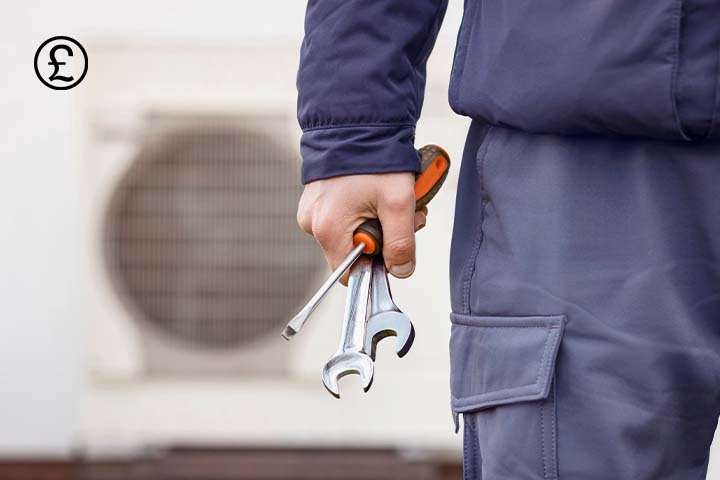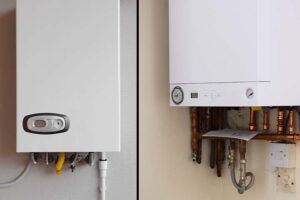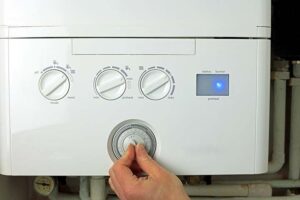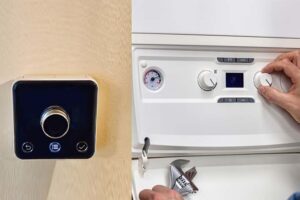If you are thinking of getting an air source heat pump (ASHP) in 2025, this guide is for you. We will discuss the rules, the cost, the process, and what to do when choosing an installer. It also answers the common questions such as: “Can I fit one myself?” and “Do I need planning permission?”
- Usually, the standard air source heat pump installation cost in 2025 can be around £7,000–£15,000. However, it varies according to house size and complexity.
- Typical duration of installation: 1–4 days on-site, but weeks or months for surveys and waiting times.
- Grants: Boiler Upgrade Scheme and ECO4 can reduce costs for qualifying low-income households.
This guide will answer all of those questions. We’ll explain everything step by step — from installation requirements to costs in 2025. We’ll also cover grants like the Air Source Heat Pump Grants UK, which can reduce or even remove the upfront cost.
What Exactly is an Air Source Heat Pump?
An air source heat pump is an environmentally friendly way to heat your home. Instead of burning fuel, it takes heat from outside air and transfers it into your home. This heat can be used for radiators, underfloor heating, and hot water.
Even at low temperatures (as low as –15°C), heat pumps work. They are much more efficient than boilers. A gas boiler is up to 92% efficient. A heat pump can be 300–400% efficient. It means you receive 3–4 units of heat from each 1 unit of electricity used.
Why Install an Air Source Heat Pump?
Heat pumps use electricity to move heat from outside air into your home. They are far more efficient than direct electric or oil heating. It delivers 3–4 units of heat for every 1 unit of electricity used (expressed in COP/SCOP).
Heat pumps are becoming popular in 2025 because:
- They cut carbon emissions as the grid gets greener.
- They reduce heating costs in the long run.
- There are grants to pay for most of the cost.
- They are future-proof as the UK is phasing out oil and non-condensing units.
Air Source Heat Pump Installation Requirements in 2025
Before you book a survey for your heat pump, make sure you know these basics:
- Outdoor space for the unit. You need a stable, level area. Ground pad or wall bracket is standard.
- Good air circulation around the outdoor unit. Don’t put it in a tight cupboard/area.
- Internal space for the hot water cylinder (if a cylinder is required in the case of DHW).
- Insulation in the loft, floors, and walls. Heat pumps function most efficiently where houses are well-insulated.
- Your electric supply. Your supply may require upgrading for certain systems or an appropriate fuse rating.
- Planning and noise checks. Follow the permitted development rules (see planning section).
How to Install an Air Source Heat Pump? Step by Step
Below is the usual process from first enquiry to handover. Times shown are typical but vary by job.
1. Initial quotes and research (1–3 weeks)
Get 2–3 quotes from MCS- or TrustMark-registered installers. Have a visit to gov.uk or MCS directories.
Ask for a full heat-loss survey (not a radiator-based estimate).
2. Home survey and heat-loss calculation (1–2 weeks)
The installer measures, checks insulation, windows, and existing radiators.
They calculate the system size in kW and recommend radiator replacement or underfloor heating if required.
3. Design and quote (1–2 weeks)
You will receive a detailed quotation. It should contain unit price, labour, cylinder (if needed), heating controls, any electrical or radiator work, and VAT.
4. Permits and grant checks (1–3 weeks)
The installer checks planning laws and noise controls. The 2025 change to the law removed the rigid 1-metre boundary limitation and eased permitted development in most cases. Check with your installer for local council regulations nearby.
If eligible for ECO4 or Boiler Upgrade Scheme, paperwork will be covered by the installer.
5. Booking the installation (wait time depends)
Due to increased demand, waiting times may be weeks or months during winter. Book ahead.
6. On-site installation (1–4 days typical)
Outdoor units to be installed on pads or brackets.
Refrigerant lines and heat pump pipework to be installed indoors.
Hot water cylinder to be fitted or connected to the existing cylinder.
Connect to electrics and controls.
The commission system and explain how to use the controls to you.
7. Aftercare
Manuals, warranties, and maintenance advice were handed over by the Installer.
Recommended annual service.
What is the 1m Rule and Planning Permission in 2025?
The “1m rule” was a previous UK regulation requiring air source heat pumps to be at least one meter from a property boundary. This 1 m rule has now been removed as of May 29, 2025, making heat pump installation much easier.
The UK government relaxed the strict 1m boundary restriction and streamlined permitted development in the majority of cases, granting permission for ASHPs on detached houses without a full planning application, provided noise limits are respected. Always check with your local council.
Noise rule: The Typical national noise limit is 42 dB at 1m from a neighbour’s window. If the pump is over permitted levels of noise, you may need planning permission or mitigation. Have your installer conduct a noise survey.
How Long Does an Air Source Heat Pump Installation Take?
Typically, you can get your new air source heat pump installed in as few as 3-5 days. But many factors may influence the timeline:
- Survey + design: 1-2 weeks (longer possibly with grant documentation).
- On-site installation: 1–4 days for the standard air source heat pump installation. More complex retrofits take several days.
- Total time from quotation to running system: Between a few days and a few weeks, depending on demand and grants.
What Does an Air Source Heat Pump Cost to Install in 2025?
The costs to install an air source heat pump depend on home size, system size, and retrofitting complexity. Typical 2025 price ranges:
- Small flat/small home: £7,000–£10,000.
- Average 3-4 bed house: £10,000–£15,000 (typical).
- Complex or larger retrofit: £15,000–£25,000+ (radiator replacement, electrical upgrade, groundworks).
Grants: Boiler Upgrade Scheme (BUS) provides £7,500 support for heat pumps. ECO4 can fully fund installations for low-income households that are eligible. Always verify the grant’s current status and adviser guidance.
Advertising costs can vary. Ask installers to break it down in full. Confirm quotes cover all extras: radiators, cylinders, electrics, scaffold, and groundworks.
Can I Install A Heat Pump Myself?
Brief answer: No, not recommended. Heat pumps involve proper refrigerant handling. Self-installing can be hazardous and illegal without F-gas and refrigeration training.
Self-fits will usually invalidate guarantees and render you ineligible for grants.
Use MCS or TrustMark-approved installers for safety, warranty, and grant eligibility.
How to Choose the Best Heat Pump Installer?
Here is the checklist to refer to when choosing a heat pump installer:
- MCS or TrustMark accredited. It is essential for quality and grants.
- Local experience with ASHPs. Ask for local references.
- Heat-loss survey in detail. Never accept sizing over the phone.
- Quote clear. It should specify kit, labour, and extras.
- Warranties and guarantees. Ask about parts and labour cover.
- Aftercare and maintenance schedules. Ask about annual maintenance.
- Research reviews and complaints. Go to Trustpilot, Google, and the MCS directories.
- Get three quotes for the best outcome.
What Exactly Happens During Heat Pump Installation?
- Site preparation: Clear the ground and install a concrete pad or bracket.
- Outside unit installation: Fix the unit, fit anti-vibration pads.
- Pipe runs and drilling: Refrigerant pipe and condensate drain holes.
- Internal works: Fit cylinder (if required), connect to radiators or underfloor. Replace controls (smart thermostats are perfect).
- Electrical connection: Connect to mains and remove switches. Supply upgrade may be required, and DNO works can be time- and expense-consuming.
- Commissioning: System charged with refrigerant, leak-tested, and operational performance tested.
Best Brands of Heat Pumps in 2025
Brands most commonly mentioned as being good in the UK in 2025 are: Mitsubishi, Daikin, Panasonic, Vaillant, NIBE, Worcester Bosch, and Viessmann. Look for:
- High winter performance (SCOP).
- Low noise running (low dB).
- Reasonable guarantees and UK service.
- Radiator upgrades or bigger radiators to supply heat at lower water temperatures.
- Underfloor heating installation.
- New hot water cylinder for homes that do not have adequate DHW storage.
- Electrical supply upgrades (perhaps needing DNO input).
- Groundworks for acoustic screen location or positioning.
- Planning application fees (if required, very rare under new regulations).
Running Costs of Heat Pumps in 2025
According to electricity prices now, heat pump operating costs are £840 to £2,280 a year (around £70 to £190 per month), depending on your property and how well insulated it is. They are 300–400% efficient in ideal circumstances (COP 3–4). That is a lot of heat per kWh of electricity used.
Cost of running will be your electricity tariff, system COP, and insulation. Heat pumps already compete with oil and electricity heating prices in most properties.
Maintenance and Lifespan of Heat Pump
With proper maintenance, heat pumps can last for around 15-20 years (some last longer). Annual maintenance is highly recommended. This ensures high levels of efficiency and warranties in operation.
Normal maintenance checks: check refrigerant level, clean filters, electrical connections, cylinder, and controls.
The Bottom Line
Air source heat pumps are a green, practical, and increasingly affordable solution in 2025. They need to meet property conditions, an accredited fitter, and probably some improvements to your property in order to perform at their optimum.
Schemes like the Boiler Upgrade Scheme and ECO4 will lower the initial cost drastically for most. For lower bills, lower carbon emissions, and a future-proofed heating system, an ASHP is definitely worth looking at.
Frequently Asked Questions
Between £7,000 and £15,000, depending on how large your home is, the levels of insulation, and whether you need new radiators or a hot water cylinder. Can the cost be paid for or minimised by the time it takes to install a heat pump?
Most installations will be 2–5 days. Smaller homes could be completed in 2–3 days, and larger properties that involve radiator upgrades or pipework may take a week.
Overall, no planning permission is needed since heat pumps are classed as permitted development. However, if your building is listed in a conservation area, or you are looking to install more than one unit, permission will be needed.
No. A heat pump must be installed by a competent MCS-qualified installer. You can’t install it yourself, as it will not meet legal standards.
Yes, in most homes they are. Even though electricity is more expensive than gas per unit, heat pumps are 3–4 times more efficient than a boiler. With proper insulation and smart use, they can lower energy bills, especially when combined with renewable electricity tariffs.








